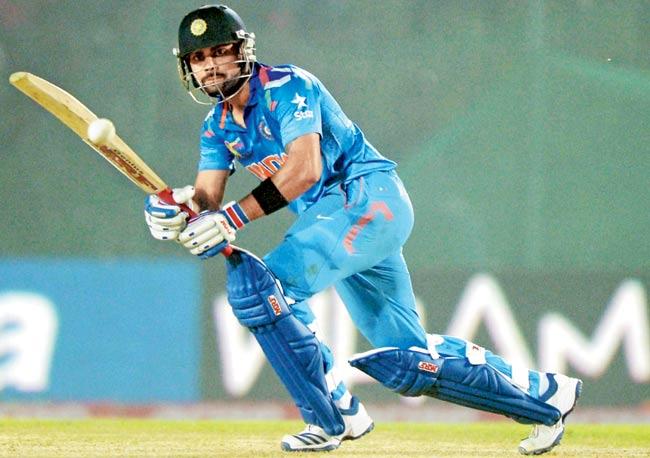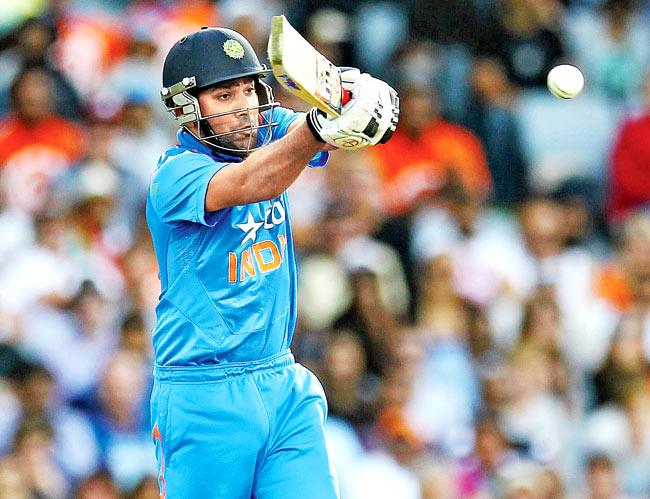Instead of starting with two pacers, Pakistan skipper starts with off-spinner Mohammad Hafeez, for he realises that in these sub-continental conditions, the new ball in a pacer's hand isn't much of a weapon

India's stand-in skipper Virat Kohli will be the key to success against Pakistan. Pic/AFP
Most fielding captains during an ODI, more often than not follow a tried and tested template with regards to their bowling — they start with two fast bowlers and continue with them till the end of the first power play, if possible. Then they bring in the lead spinner between the 12th-15th over while the third seamer operates from the other end.
India's stand-in skipper Virat Kohli will be the key to success against Pakistan. Pic/AFP
Once the third seamer has bowled 4-5 overs, they then replace him with the second spinner in the team. The spinners and the part-timers are allowed to bowl for the next 20 odd overs unless someone goes absolutely berserk, which rarely happens in this day and age. Batting team takes the batting power play in the 36th and that's when they bring back the two best bowlers for the job, finishing the back 10 with the remaining overs of three fast bowlers and, may be, a couple of the spinners.
ADVERTISEMENT

India’s opening batsman Rohit Sharma who must get his act together today against Pakistan in the Asia Cup at Dhaka. Pic/Getty Images
The response of the batting side to this sort of a template is something on these lines —respect the two new balls, accelerate a little bit between 6-10th over, get into the milking mode once the fielding restrictions are lifted, continue the same way till the batting power play is available with not more than three wickets down and then go hammer and tongs in the last 15.
With only four fielders outside the circle, ball not reverse swinging, because it's not too old even in the last 10, and the general decline in the quality of death bowling, most teams manage close to a 100 runs in the back 10, give and take a few. In cricket, like in a battlefield, if the captain decides to abandon this tried and tested method of combat, the opposition is sure to be caught unawares.

Instead of starting with two faster men, Misbah starts with Hafeez from one end, for he realises that in these sub continental conditions the new white ball in a fast bowler's hand isn't a weapon but a white flag requesting for mercy. The ball rarely swings and the harder ball is easier to dispatch on these pitches. The faster you bowl the quicker it goes off the bat. Hence, he takes the pace off the ball right at the beginning. Then instead of bringing in the best spinner, Misbah brings his third/fourth seamer after the mandatory power play gets over.
He introduces his best bowler - Ajmal around the 20th over, for he never bowls more than four overs in that spell. While the batsmen are milking the middle overs hoping to build on that momentum, Misbah waits for the ball to get old and tighten the screws in the back 20. In the opening encounter, Sri Lanka were 175-1 at the end of the 30th over. On most days you can double that score in the last 20, but little did Sri Lanka realise that Ajmal, Gul, Junaid and Afridi had more than five overs each left at that stage.
Super Gul
Just when Sri Lanka started building, Gul removed Sangakkara and then Ajmal removed the other set batsman Thiramanne in the first over of the batting power play. Pakistan continued to tighten the noose with the old ball and it was only the phenomenal batting effort by Mathews that finally made their total look respectable. Even then Sri Lanka managed only 64 in the last 10 overs. What looked like a total of 350 ended up four short of 300 runs. The best way to deal with Pakistan is to adopt the same policy, for the traditional warfare would mean playing straight into their hands.
India must go after Hafeez in the first few and force Misbah to consume a few overs of the faster men at the start. It's also imperative to not take the foot off the pedal in the overs following the power play. Then, as soon as there are two set batsmen in the middle and Ajmal is done with his first 3-4 overs spell, take the batting power play. Now, instead of feeling obliged to up the ante in the power play, the idea should be to not lose any wickets, runs be damned.
This would mean Ajmal bowling at least three more of his quota, which will leave him with only three in the remaining 20 overs. The best chance of beating Pakistan is to beat them in their own game. India's approach in the game against Pakistan is sure to give us a peep into India's coaching staff's inputs and thought process, both of prime importance.
 Subscribe today by clicking the link and stay updated with the latest news!" Click here!
Subscribe today by clicking the link and stay updated with the latest news!" Click here!







